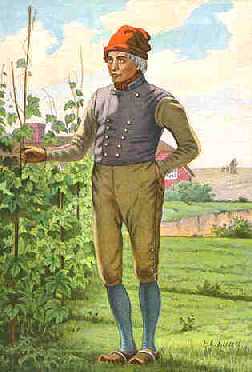Knit cap
Knit cap, also known as a beanie, stocking cap, or tuque, is a type of headwear designed for warmth. The knit cap is a key piece in winter attire, often made from wool, cotton, or synthetic fibers. Its primary function is to provide warmth and protection against cold weather, making it a staple in regions experiencing cold climates. The design of knit caps can vary significantly, from simple, solid colors to complex patterns and embellishments.
History[edit | edit source]
The origins of the knit cap can be traced back to seafarers and workers in cold climates who needed headgear that was both warm and compact. Over time, the knit cap transitioned from a purely functional item to a fashionable accessory. Different cultures have contributed to the evolution of the knit cap, with variations such as the Scandinavian Nordic patterns and the Canadian tuque.
Design and Variations[edit | edit source]
Knit caps come in various designs, including the cuffed and uncuffed versions. The cuffed version allows for adjustment in size and thickness around the ears, while the uncuffed version provides a more streamlined look. Some knit caps include pompoms or tassels, adding a decorative element. The material and knitting technique influence the cap's warmth, texture, and appearance. High-quality wool, such as Merino wool, is prized for its softness, warmth, and breathability.
Cultural Significance[edit | edit source]
In addition to its practical uses, the knit cap holds cultural significance in various communities. It has been adopted by numerous subcultures and fashion movements over the years. In sports, especially in ice hockey and snowboarding, knit caps are a common sight, often bearing team logos and colors. They are also prevalent in urban and streetwear fashion, symbolizing a relaxed and trendy aesthetic.
Knitting Techniques[edit | edit source]
Knitting a cap involves techniques such as ribbing, which provides elasticity, and stockinette stitch, which offers a smooth finish. Advanced patterns may include cable knits or colorwork, such as Fair Isle, adding complexity and visual interest to the cap. Knitting a cap can be a beginner-friendly project, but it also offers opportunities for skill advancement.
Environmental Considerations[edit | edit source]
With growing awareness of sustainable fashion, the choice of materials for knit caps has gained importance. Natural fibers like wool and cotton are renewable and biodegradable, but their production has environmental impacts. Synthetic fibers, while durable and often less expensive, contribute to plastic pollution. The environmental footprint of a knit cap also includes considerations of production methods, transportation, and longevity.
See Also[edit | edit source]
Navigation: Wellness - Encyclopedia - Health topics - Disease Index - Drugs - World Directory - Gray's Anatomy - Keto diet - Recipes
Search WikiMD
Ad.Tired of being Overweight? Try W8MD's physician weight loss program.
Semaglutide (Ozempic / Wegovy and Tirzepatide (Mounjaro / Zepbound) available.
Advertise on WikiMD
WikiMD is not a substitute for professional medical advice. See full disclaimer.
Credits:Most images are courtesy of Wikimedia commons, and templates Wikipedia, licensed under CC BY SA or similar.Contributors: Prab R. Tumpati, MD





